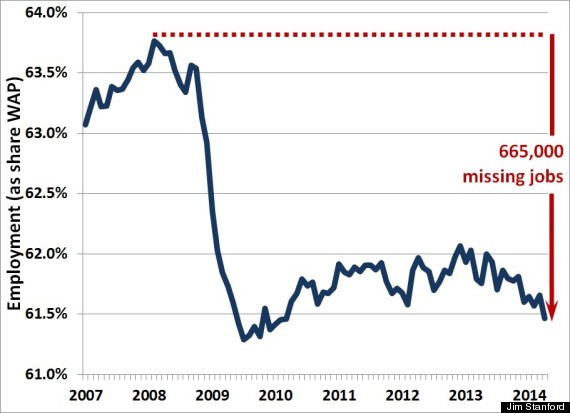If the percentage of Canadians with a job today were the same as it was before the last recession, Canada would have 665,000 more working people, according to economist Jim Stanford.

Source: huffingtonpost.ca/
Author: The Huffington Post Canada | By Daniel Tencer
Canada lost 28,900 jobs in April, StatsCan reported, surprising economists who had been looking for the economy to add about 12,000 jobs.
But Canada’s unemployment rate didn’t budge, sitting at 6.9 per cent. That’s because about 26,000 Canadians simply stopped looking for work, and therefore stopped being counted among the unemployed.
Canada’s employment rate — essentially the percentage of people who have a job — fell to 62.1 per cent, from 62.4 per cent a year earlier.
That’s the lowest rate since 2010, when Canada was struggling to climb out of the global financial crisis, notes Stanford, an economist with the United Auto Workers. The rate has been in steady decline since mid-2012.
(Another measure of this data, the labour force participation rate, is at its lowest point since 2001, at 66.1 per cent.)
The latest drop was “mainly the result of a decline in the participation rate of the population aged 25 to 54, the group most likely to participate in the labour market,” StatsCan noted.
By Stanford’s calculations, if Canada’s employment rate bounced back to its pre-recession peak, there would 665,000 more Canadians working today than there actually are.

“Less than a tenth of the damage done to the employment rate in the recession has been repaired,” Stanford writes in a blog post at the Progressive Economics forum.
Stanford says the Harper government’s clam that Canada has more jobs today than it did before the recession is misleading — it ignores the fact Canada’s working-age population has 2 million more people today than it did before the recession, and job creation hasn’t kept up.
To be sure, Canada isn't the only developed country facing this problem in the post-recession era. It's worse in the U.S., where the comparable employment rate is three percentage points lower, at 58.9 per cent. However the U.S. rate rose in the most recent jobs report, by 0.3 percentage points.
Stanford lays part of the blame on government austerity measures. While government stimulus was in place during the post-recession period, the employment rate was growing, he says, but then it started declining again “as government switched from gas to brake, and austerity became the dominant theme of fiscal policy.”
Stanford says the phenomenon of people leaving the labour force is "not surprising” given the “general stagnation” of the main drivers of economic growth.
He notes that over the past year, increased consumer spending was the main source of economic growth. Housing, business investment and government spending contributed nothing to GDP growth, though increased trade contributed a small portion. And with household debt at record-high levels, consumers can’t be expected to just keep borrowing to rescue the economy.
This “illustrates starkly that Canada’s economy has no engine,” Stanford writes.
“In the absence of private sector leadership, government must lead the way with more investment and spending, not less.”
Original Article
Source: huffingtonpost.ca/
Author: The Huffington Post Canada | By Daniel Tencer

No comments:
Post a Comment